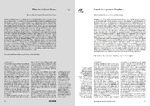Mostrar o rexistro simple do ítem
Cuando los arquitectos dibujaban…
| dc.contributor.author | Amado, Antonio | |
| dc.contributor.author | Fraga López, Fernando | |
| dc.date.accessioned | 2024-03-22T11:41:19Z | |
| dc.date.available | 2024-03-22T11:41:19Z | |
| dc.date.issued | 2023-04-21 | |
| dc.identifier.citation | Amado Lorenzo, A., y Fraga López, F. (2021). Cuando los arquitectos dibujaban…. XY. Rassegna critica di studi sulla rappresentazione dell’architettura e sull’uso dell’immagine nella scienza e nell’arte, 6(11-12), 94–107. https://doi.org/10.15168/xy.v6i11-12.2523 | es_ES |
| dc.identifier.issn | 2499-8346 | |
| dc.identifier.uri | http://hdl.handle.net/2183/35962 | |
| dc.description.abstract | [Resumen] El interés por el dibujo a mano alzada en las escuelas de arquitectura agoniza sin que los recientes planes de estudios sean conscientes del problema. Las sobrevaloradas aplicaciones informáticas de arquitectura absorben las energías de unos estudiantes que ya no consideran que sea una herramienta tan importante como para dedicar a su aprendizaje un tiempo del que no disponen. La atracción adictiva hacia las redes sociales y el infinito material audiovisual de consumo absorben un tiempo que antes dedicado a leer y dibujar. Durante una docena de años hemos encuestado a nuestros alumnos (351) de varios cursos sobre su relación con el dibujo a mano alzada. Los temas de la encuesta fueron pocos pero ilustrativos: 1. Frecuencia (práctica habitual), 2. Utilidad (idear, pensar, representar, etc.), 3. Capacidad (autovaloración personal), y 4. Necesidad (dibujo en la carrera y en la profesión de arquitecto). Algunas respuestas son significativas aunque bastante contradictorias: un 55% de los alumnos dibuja sólo para desarrollar un proyecto; un 7% no dibuja nunca o lo menos posible; un 25% lo hace solamente para sus proyectos terminados; un 2% se reconoce capaz de resolver cualquier reto con el dibujo, pero un 2%, se considera negado; a un 75% le gustaría dibujar mejor; para un 90% debería potenciarse el dibujo de pensamiento, mientras que un 46% lo considera imprescindible para un arquitecto. Se confirman por tanto tendencias resumidas en una afirmación rotunda: los estudiantes de arquitectura no dibujan habitualmente. No es fácil modificar esta tendencia y difícil cambiar su mentalidad sobre la importancia que el dibujo tiene para el arquitecto. Más allá de reflexionar sobre las causas de la situación, el artículo plantea que las tabletas gráficas digitales, utilizadas como nueva técnica de dibujo a mano alzada podrían facilitar su aprendizaje por la facilidad de uso, edición ilimitada, tecnología atractiva, etc. evitando el desalentador horror vacui de técnicas tradicionales. | es_ES |
| dc.description.abstract | [Abstract] Interest in freehand drawing in architecture schools is dying without recent study plans being aware of the problem. The overrated computer applications developed for architecture absorb the energies of students who no longer consider it to be such an important tool that they dedicate time to their learning that they do not have. The addictive attraction to social networks and the infinite audiovisual material for consumption absorb time that was previously dedicated to reading and drawing. For a dozen years we have surveyed our students (351) from various architecture courses about their relationship to freehand drawing. The survey topics were few but illustrative: 1. Frequency (usual practice), 2. Usefulness (devise, think, represent…), 3. Capacity (personal self-assessment), and 4. Necessity (drawing in the career and in the profession of architect). Some answers are significant although quite contradictory: 55% of the students draw only to develop a project; 7% never draw or draw as little as possible; 25% do it only to represent their finished projects; 2% consider themselves capable of solving any challenge with the drawing, but 2% consider themselves denied; 75% would like to draw better; For 90%, the drawing of thought should be promoted, while 46% consider it essential for an architect. Trends are therefore confirmed, summarized in a resounding statement: architecture students do not usually draw. It is not easy to change this trend and difficult to change their mentality about the importance of drawing for the architect. Beyond reflecting on the causes of the situation, the article suggests that graphic digital tablets, used as a new freehand drawing technique, could facilitate their learning due to their ease of use, unlimited editing, attractive technology, etc. avoiding the daunting horror vacui of traditional techniques. | es_ES |
| dc.language.iso | spa | es_ES |
| dc.publisher | Università degli studi di Trento – Dipartimento di Ingegneria Civile, Ambientale e Meccanica | es_ES |
| dc.relation.uri | https://doi.org/10.15168/xy.v6i11-12.2523 | es_ES |
| dc.rights | Atribución-NoComercial-CompartirIgual 3.0 España | es_ES |
| dc.rights.uri | http://creativecommons.org/licenses/by-nc-sa/3.0/es/ | * |
| dc.subject | Architecture studies | es_ES |
| dc.subject | Digital tablets | es_ES |
| dc.subject | Freehand drawing | es_ES |
| dc.subject | Dibujo manual | es_ES |
| dc.subject | Estudios de arquitectura | es_ES |
| dc.subject | Tabletas digitales | es_ES |
| dc.title | Cuando los arquitectos dibujaban… | es_ES |
| dc.title.alternative | When the Architects Drew... | es_ES |
| dc.type | info:eu-repo/semantics/article | es_ES |
| dc.rights.access | info:eu-repo/semantics/openAccess | es_ES |
| UDC.journalTitle | XY: Rassegna critica di studi sulla rappresentazione dell’architettura e sull’uso dell’immagine nella scienza e nell’arte | es_ES |
| UDC.volume | 6 | es_ES |
| UDC.issue | 11-12 | es_ES |
| UDC.startPage | 94 | es_ES |
| UDC.endPage | 107 | es_ES |
Ficheiros no ítem
Este ítem aparece na(s) seguinte(s) colección(s)
-
GI-GIRAP - Artigos [50]






